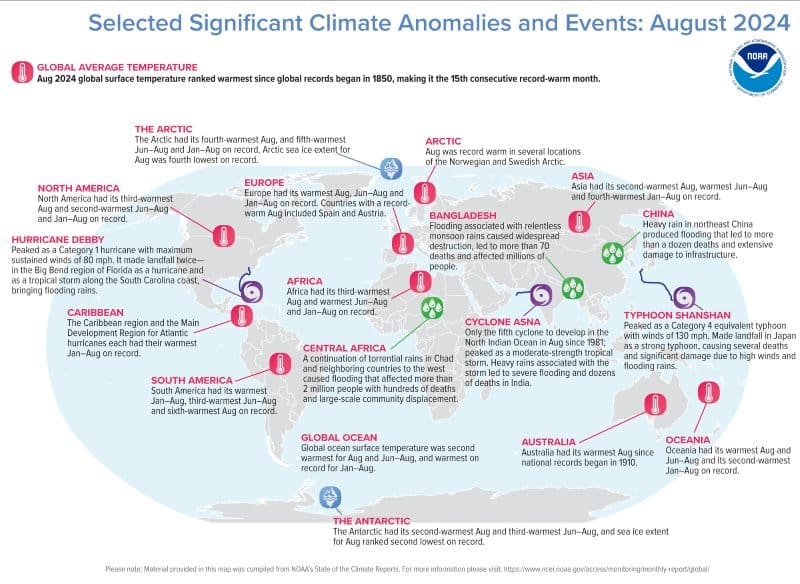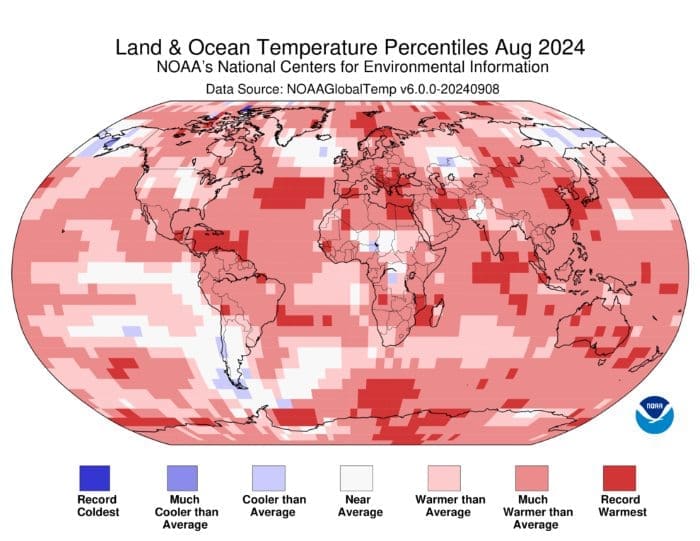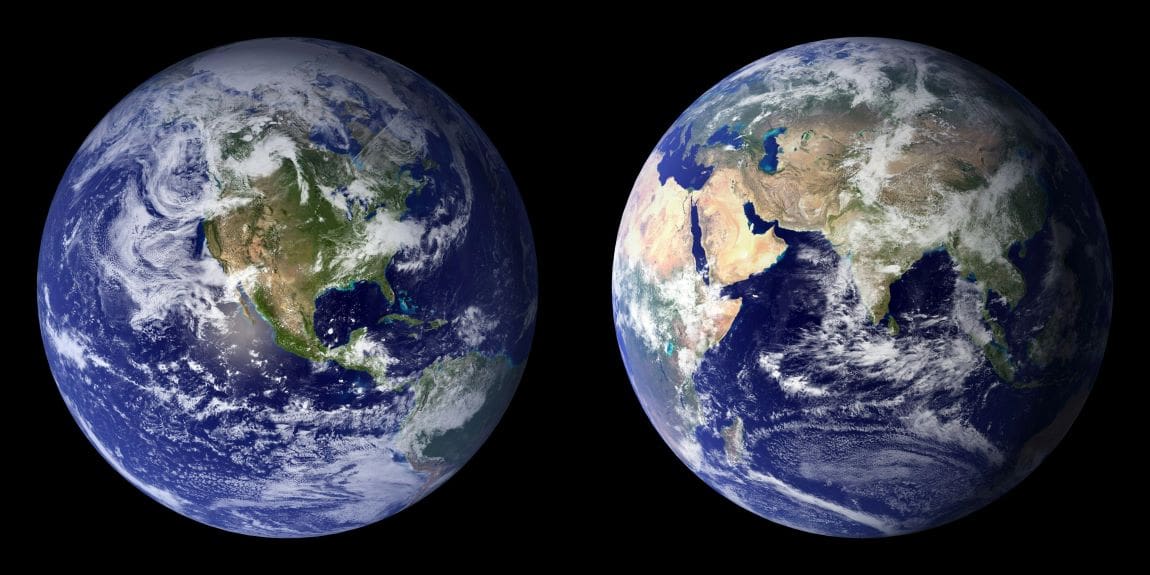The 15th consecutive month of record-setting global temperatures and the second-lowest Antarctic sea ice extent again.
The latest NOAA global climate report for August 2024 reveals a concerning continuation of the planet’s warming trend. With temperatures reaching new highs and sea ice shrinking to alarming lows, the August report provides further evidence of the accelerating impacts of climate change.
August 2024 stands as the 15th consecutive month of record-high global temperatures, marking a significant milestone in the climate crisis. Additionally, the report highlights that Antarctic sea ice extent was the second-lowest on record, underscoring the rapid pace of ice melt in polar regions.

Global temperature records shattered
August 2024 saw global surface temperatures soar to 2.29°F (1.27°C) above the 20th-century average of 60.1°F (15.6°C), making it the warmest August since record-keeping began. This extends the streak of record-high temperatures to 15 consecutive months, the longest stretch on record. According to the National Centers for Environmental Information (NCEI), there is a 97% likelihood that 2024 will go down as the hottest year in recorded history.
Europe, Oceania, and parts of Asia experienced their warmest August on record, while Africa and North America registered their third warmest. South America had its sixth warmest August, reflecting the widespread impacts of rising temperatures. Approximately 10% of the Earth’s surface recorded record-high August temperatures, and the global ocean surface temperature ranked second highest ever for this month.
Sea surface temperatures were above average across much of the globe, although certain regions, such as the tropical eastern Pacific and portions of the Atlantic, recorded below-average temperatures. Notably, 9.8% of the world’s oceans saw record-warm temperatures in August, the highest proportion since 1951. By contrast, only 0.2% of global oceans recorded record cold temperatures.


Satellite data provided by the National Environmental Satellite, Data, and Information Service (NESDIS) showed that temperatures in the mid-troposphere, a layer 2–6 miles above Earth, were also record warm in August. This continues a pattern of record-setting mid-tropospheric temperatures that has lasted for the past 14 months, emphasizing the depth and severity of warming throughout the Earth’s atmosphere.
Regional climate impacts
Europe experienced its warmest August on record. Austria’s temperatures soared 3.0°C (5.4°F) above the 1991–2020 average in the Lowlands, and 3.3°C (5.9°F) higher in the mountain regions, the warmest in a series dating back 258 years. In Spain, the August heatwave brought temperatures 2.0°C (3.6°F) above the recent average, making it the hottest August since 1961. Germany, Switzerland, and the United Kingdom also faced above-average temperatures, with Germany tying for its fourth-warmest August on record. Meanwhile, the Caribbean Islands saw their warmest August ever, breaking last year’s record.
In Asia, Japan and Turkey both experienced extreme heat, with Japan registering its second-warmest August since records began in 1898. In the Pacific region, Australia had its hottest August since 1910, with temperatures 3.03°C (5.45°F) above the 1961–1990 average, while New Zealand had its ninth-warmest August since 1909.
In the Southern Hemisphere, the August 2024 temperature ranked as the warmest on record at 1.06°C (1.91°F) above average. The ocean-only temperature in this hemisphere was second highest on record, while the land-only temperature was the highest. The Antarctic region recorded its second-warmest August ever, with temperatures rising 1.85°C (3.33°F) above average.
Shrinking sea ice and snow cover
Alongside record-high temperatures, the August 2024 report also highlights significant reductions in global sea ice extent. The global sea ice extent was the second smallest ever recorded, with an area of 8.32 million square miles – 1.05 million square miles below the 1991–2020 average. Arctic sea ice extent was 470,000 square miles below the average, marking the fourth-lowest on record, while Antarctic sea ice extent was 580,000 square miles below average, making it the second-lowest on record.
Snow cover in the Northern Hemisphere was near average, with a slight surplus in North America and a small deficit in Eurasia. However, in the most northern regions, such as the Canadian Arctic Archipelago and coastal Greenland, above-average snow cover was observed, providing a counterpoint to the general trend of warming and ice melt.
Tropical cyclone activity
Tropical cyclone activity in August was close to average, with 15 named storms worldwide. The Atlantic Basin experienced two significant hurricanes: Debby, which made landfall in Florida as a Category 1 hurricane, and Ernesto, which struck Bermuda as a Category 2 storm. The East Pacific saw an uptick in activity with seven tropical cyclones, while the West Pacific recorded five, and the North Indian Ocean saw one.
Implications for the future
The August 2024 report from NOAA presents a stark picture of a planet experiencing profound and rapid climate shifts. The combination of record-setting temperatures, shrinking sea ice, and ongoing tropical cyclone activity points to an increasingly volatile and warming world. With NOAA’s Climate Prediction Center forecasting a high likelihood of La Niña conditions developing in the coming months, the near future could see further extreme weather patterns, including continued warming and regional variations in temperature and precipitation.
The persistence of these climate trends underscores the urgent need for global action to mitigate the causes of climate change. As August 2024 becomes the warmest on record, the pressure on nations to cut greenhouse gas emissions and adapt to a warming world grows ever more pressing.
Source:
NOAA National Centers for Environmental Information, Monthly Global Climate Report for August 2024, published online September 2024
Featured image credit: Pixabay | Pexels




